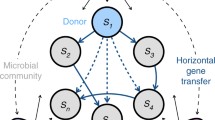Summary
Many bacterial species carry plasmids that encode both the production of a highly specific toxin (bacteriocin) that kills competitors of the same species and immunity to that toxin. A great diversity of bacteriocins is produced within a single species. I present a model for the dynamics of competition between allelopathic and susceptible types. The model applies to most kinds of allelopathic competition. My primary goal is, however, to explain the widespread genetic polymorphism for bacteriocins. The model includes competition for scarce resources, competition through toxin production, spatial diffusion of individuals and toxins at varying rates and spatial variation in habitat quality. I draw three main conclusions from this ‘reaction—diffusion’ model. (1) Polymorphism of toxin producers and susceptibles cannot be maintained within a single spatial location when individuals and the toxin mix randomly. (2) Susceptibles are generally favoured in poor habitats, where the rate of resource competition per interaction increases relative to the resource-independent rate of toxic killing. By contrast, toxic producers are generally favoured in good habitats, where the rate of resource competition is lower. (3) Spatial variation in habitat quality can lead to spatial polymorphism; susceptibles tend to win in poor habitats and producers tend to win in good habitats.
Similar content being viewed by others
References
Adams, J., Kinney, T., Thompson, S., Rubin, L. and Helling, R.B. (1979) Frequency-dependent selection for plasmid-containing cells ofE. coli. Genetics 91, 627–37.
Ames, W. F. 1992.Numerical Methods for Partial Differential Equations, 3rd edn. Academic Press, New York.
Chao, L. and Levin, B.R. (1981) Structured habitats and the evolution of anticompetitor toxins in bacteria.Proc. Natl Acad. Sci. USA 78, 6324–8.
Chhibber, S., Goel, A., Kapoor, N., Saxena, M. and Vadehra, D.V. (1988) Bacteriocin (klebocin) typing of clinical isolates ofKlebsiella pneumoniae.Eur. J. Epidemiol. 4, 115–18.
Fisher, R.A. (1937) The wave of advance of advantageous genes.Ann. Eugen. 7, 355–69.
Frank, S.A. (1989) The evolutionary dynamics of cytoplasmic male sterility.Am. Nat. 133, 345–76.
Frank, S.A. (1993) Coevolutionary genetics of plants and pathogens.Evol. Ecol. 7, 45–75.
Gaston, M.A., Strickland, M.A., Ayling-Smith, B.A. and Pitt, T.L. (1989) Epidemiological typing ofEnterobacter aerogenes.J. Clin. Microbiol. 27, 564–5.
Grime, J.P. (1977) Evidence for the existence of three primary strategies in plants and its relevance to ecological and evolutionary theory.Am. Nat. 111, 1169–94.
Grun, P. (1976)Cytoplasmic Genetics and Evolution. Columbia University Press, New York.
Hardy, K.G. (1975) Colicinogeny and related phenomena.Bacteriol. Rev. 39, 464–515.
Levin, B.R. (1988) Frequency-dependent selection in bacterial populations.Phil. Trans. R. Soc. Lond. B 319, 459–72.
Levin, S.A. (1979) Non-uniform stable solutions to reaction—diffusion equations: applications to ecological pattern formation. InPattern formation by dynamic systems and pattern recognition (H. Haken, ed.), pp. 210–22. Springer-Verlag, New York.
Lewin, B. (1977)Gene Expression, Volume 3: Plasmids and Phages. Wiley, New York.
Mimura, M. (1984) Spatial distribution of competing species. InMathematical ecology. Lecture notes in biomathematics Vol. 54 (S. A. Levin and T. G. Hallam, eds), pp. 492–501. Springer-Verlag, New York.
Mimura, M., Ei, S.-I. and Fang, Q. (1991) Effect of domain-shape on coexistence problems in a competition-diffusion system.J. Math. Biol. 29, 219–37.
Murray, J.D. (1989)Mathematical Biology. Springer-Verlag, New York.
Odell, G.M. (1980) Qualitative theory of systems of ordinary differential equations, including phase plane analysis and the use of the Hopf bifurcation theorem. InMathematical models in molecular and cellular biology. (L.A. Segel, ed.), pp. 649–727. Cambridge University Press, Cambridge.
Okubo, A. (1980)Diffusion and Ecological Problems: Mathematical Models. Springer-Verlag, New York.
Press, W.H., Teukolsky, S.A., Vetterling, W.T. and Flannery, B.P. (1992)Numerical Recipes in C, 2nd edn. Cambridge University Press, Cambridge.
Reeves, P. (1972)The Bacteriocins. Springer-Verlag, New York.
Rice, E.L. (1984)Allelopathy. Academic Press, New York.
Riley, M.A. and Gordon, D.M. (1992) A survey of Col plasmids in natural isolates ofEscherichia coli and an investigation into the stability of Col-plasmid lineages.J. Gen. Microbiol. 138, 1345–52.
Rocha, E.R. and de Uzeda, M. (1990) Antagonism amongBacteriodes fragilis group strains isolated from middle ear exudates from patients with chronic suppurative otitis media.Ear, Nose, Throat J.,69, 614–18.
Rosenzweig, M.L. (1987) Community organization from the point of view of habitat selectors. InOrganization of communities: past and present (J.H.R. Gee and P.S. Giller, eds), pp. 469–90. Blackwell Scientific, Oxford.
Rosenzweig, M.L. (1991) Habitat selection and population interactions: the search for mechanism.Am. Nat. 137, S5-S28.
Segel, L.A. (1972) Simplification and scaling.SIAM Rev.,14, 547–71.
Senior, B.W. and Vörös, S. (1989) Discovery of new morganocin types ofMorganella morganii in strains of diverse serotype and the apparent independence of bacteriocin type from serotype of strains.J. Med. Microbiol. 29, 89–93.
Thompson, J.E. (1985) Exudation of biologically-active metabolites in the spongeAplysina fistularis. I. Biological evidence.Marine Biol. 88, 23–6.
Thompson, J.E., Walker, R.P. and Faulkner, D.J. (1985) Screening and bioassays for biologically-active substances from forty marine sponge species from San Diego, California.Marine Biol. 88, 11–21.
Traub, W.H. (1991) Bacteriocin typing and biotyping of clinical isolates ofSerratia marcescens.Int. J. Med. Microbiol. 275, 474–86.
Twizell, E.H., Wang, Y. and Price, W.G. (1990) Chaos-free numerical solutions of reaction — diffusion equations.Proc. R. Soc. Lond. A 430, 541–76.
Author information
Authors and Affiliations
Rights and permissions
About this article
Cite this article
Frank, S.A. Spatial polymorphism of bacteriocins and other allelopathic traits. Evol Ecol 8, 369–386 (1994). https://doi.org/10.1007/BF01238189
Issue Date:
DOI: https://doi.org/10.1007/BF01238189




